JFK Visits Fort Bragg 12 October 1961
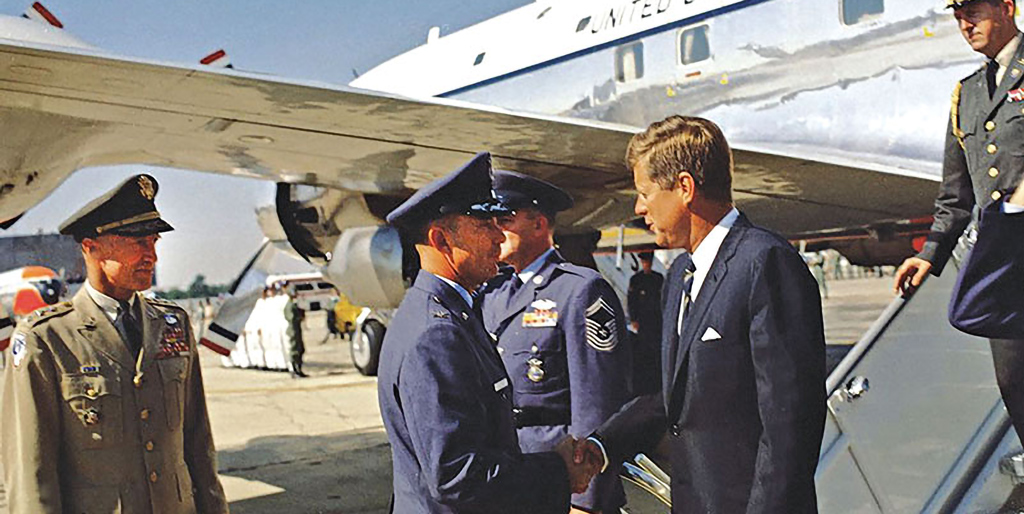
1_jfk_exiting_airforce_one
President John F. Kennedy was welcomed by the Pope Air Force Base commander and LTG Thomas J. H. Trapnell, the Third U.S. Army commanding general.
By Maj. Ray Ambrozak, U.S. Army (Ret.)
Not too long ago, I read an article about President Kennedy’s visit to Ft. Bragg in October 1961. It was during this visit that JFK made the green beret the official headgear of Special Forces. This brought back a lot of memories from those days, which I thought I would share with members of the Special Operations community.
I was a 1st Lt. in the “other unit” that made up the Special Warfare Center, the 1st Psywar Battalion. (Broadcast & Loud Speaker). It was shortly after returning from Laos (Operation White Star) that our Battalion Commander assigned me as Psywar Project officer for the presidential visit. Because the event was three months away, I thought there would be time for some leave, a little fishing, some golf maybe and working with my unit.
This was fanciful thinking on my part which became abundantly clear at the first planning conference chaired by Gen. Yarborough, commander of the Special Warfare Center. At that meeting and the many others that followed, the degree of effort and intensity that went into every detail carried the message that this was to be more than putting your best boot forward for the commander-in-chief. It was as if the viability of the Special Forces as a continuing part of the Army’s ability to respond to a variety of national security threats was dependent on the success of the visit. President Kennedy, of course, was already invested in the Special Forces, so perhaps what they wanted was for this face-to-face experience to be an affir-mation of the confidence he had in Special Forces.
What it all translated into was a full-time job for all the project offi-cers and the focal point for most of Ft. Bragg’s activities for the ensuing three months. The first major milestone of the project was a full-dress rehearsal of the entire show to be presented to members of the Dept. of Army and DOD staff, six weeks prior to the visit. By that time, preparations were well underway, such as dredging the lake at the site of the outdoor briefing and building the road that would be used by the vehicles carrying exhibits past the reviewing stands constructed for the demonstration.
If there was any doubt about the significance that was attached to this event, it was dispelled when the Pentagon entourage ascended the reviewing stand to watch the rehearsal. Ten stars twinkled in the sunlight that day as the five general officers surveyed what had been agonized over the previous six weeks. Their critique of what had been prepared at that point in the process had us going back to the drawing board to rework most of the presentation. It didn’t put things back on square one, but we were not past square two. A second pentagon review was scheduled and the time and effort of everyone involved was redoubled in order to meet that timeline with a product that would satisfy the purpose of the occasion. This was accomplished as so many things of this nature are in the military – hard work by dedicated people who want to do the very best they can for their organization and their country.
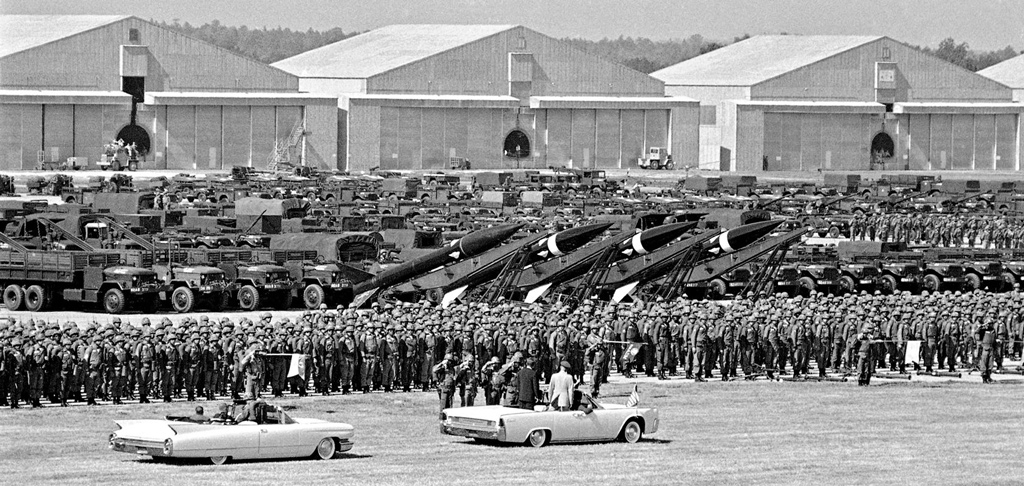
2_reviewing_troops
President Kennedy ‘trooped the line of paratroopers; note the Honest John sur-face-to-surface nuclear-capable rockets, which can be seen behind the soldiers.
The big day finally arrived. Air Force One with President John F. Kennedy aboard roared into Pope Air Force Base. As the President deplaned our Battalion photographer took several pictures of him be-ing greeted by commanders and dignitaries. Then the photographer was whisked away to the publications platoon in the Bn. Area. The plan was to demonstrate a battlefield quick reaction leaflet capability of the 1st Psywar Battalion (B&L) by taking a photo of his arrival, then several hours later dropping 5,000 leaflets on him with that picture on them.
After reviewing a full field layout of the 82nd Airborne on a runway at Pope AFB and briefings at the headquarters, the President was taken to the lake for the outdoor demonstrations. The presentation was conducted using a small convoy of tractors pulling trailers or lowboys with exhibits on them stopping briefly in front of the grand-stand while a narrator briefed the exhibit. Everything went off as rehearsed without incident.
There were a few things that stand out in memory. A Special Forces A-team in full gear with weapons was mounted on a lowboy which stopped in front of the grandstand. The plan called for each team member to jump off the vehicle to the ground and stand there as his function was briefed. This must not have been made known to the secret service because when the first A-team member jumped off the lowboy, two agents moved quickly toward the President one hand inside of their coat. They moved back just as quickly when it was obvious there was no danger to the President. As the A team was being driven away from the stands the narrator was saying the A team has the capability of organizing and training a guerrilla force of 500 personnel. As these words traveled across the water a resounding roar came echoing back from the “guerrilla force” that had been concealed behind trees and bushes on the opposite side of the lake. About a hundred plus 82nd Airborne soldiers in total camouflage had been installed there prior to the arrival of the President and they leaped out of their hiding places (of the last hour and a half) brandishing weapons and shouting war cries.
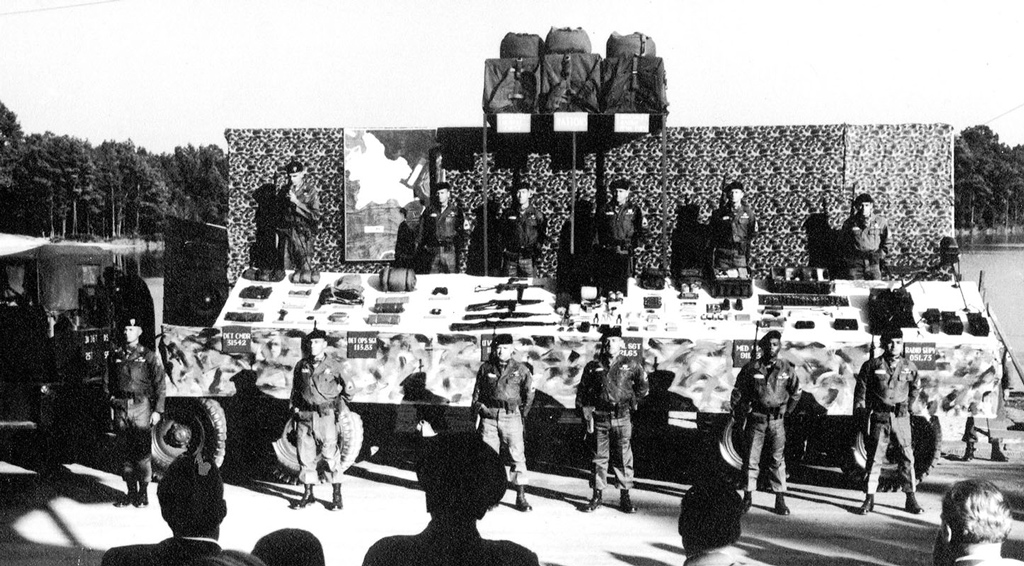
3_ateam_on_flatbed
An SF ODA displayed its organic weaponry and communications equip-ment. Half of the ODA ‘double-timed’ alongside the trailer as it moved.
Our portion of the demo was near the end. There were three exhibits, then a van with a mobile printing press in it. After watching hand-to-hand combat, soldiers moving swiftly down ropes of the rappelling walls and a slide for life, our loudspeaker team seemed tame. When the mobile radio broadcasting vehicles were in front of the grand-stand, I noticed Gen. Yarborough was doing a lot of talking to the President. We had prepared briefing papers on each of our exhibits and it was apparent he was putting them to good use. A prototype of a leaflet rolling machine, which truly looked like a Rube Goldberg device, provided some excitement when it looked like it might tip over and fall off its trailer. Our final exhibit was the mobile printing press which, as the narrator would say, had the capability of printing one million leaflets in a 24-hour period. There was radio contact with two aircraft giving them a countdown to the time on target when the narra-tor would speak the line and bingo! There were thousands of leaflets streaming out of the aircraft forming a gigantic paper cloud above us.
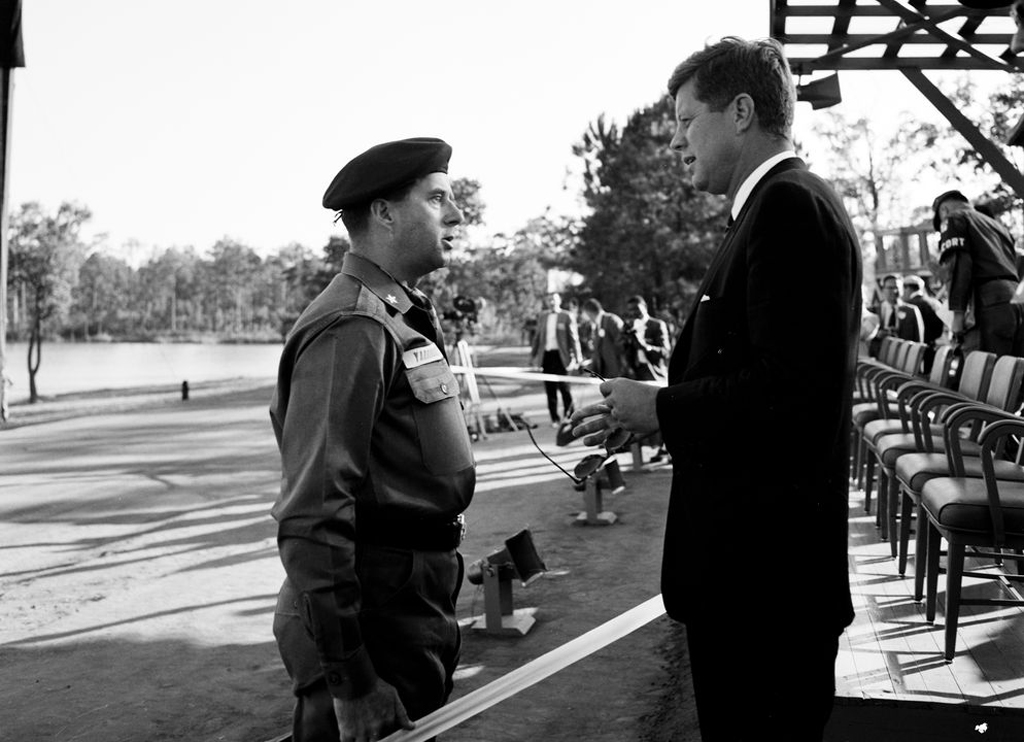
4_JFKWHP-ST-A5-8-61
General Yarborough speaking with President Kennedy;
The last part of the demo was given to transportation R&D. They had two things that they wanted the President to see. One was an amphibious truck which drove from the viewing stand down to the lake, then into the water, its oversized tires propelling it to the center of the lake. The narrator then began talking about the battlefield of the future and how the soldiers would cross the battlefield. As he spoke, a figure stepped out from a cab on the amphibian. He had some tanks on his back and a controlling device in each hand. When he fired up the unit there was a loud jet like sound, and he was lifted into the air. As he moved out 15 ft. over the water, the jets of air created a huge spray behind him making him a flying silhouette moving across the water to the reviewing stand where he landed and delivered a salute to President Kennedy. The two people closest to jet packman as he came down to earth were the two secret service agents who must have been hoping this was the last surprise for the day.

With the demo concluded, President Kennedy and Gen. Yarborough climbed into a big Cadillac convertible with the top down and began to slowly drive away. Still coming down were the last of the leaflet cloud, and as luck would have it, several found their way into the convertible as it skirted the lake. I remember hoping that one of them was one of the 5,000 with his picture. And so, the Commander- in-Chief was leaving Ft. Bragg having made two significant accomplishments. The green beret was now official headgear of Special Forces and POTUS was taking home a leaflet printed by the 1st Psywar Battalion. (B&L)
Editor’s note: The accompanying photos are public domain courtesy the U.S. Army and the JFK Presidential Library. They can be viewed along with some excellent videos at https://arsof-history.org/articles/v14n2_jfk_fort_bragg_visit_page_1.html and https://www.jfklibrary. org/asset-viewer/archives/JFKWHP/1961/Month%2010/Day%2012/JFKWHP-1961-10-12-D?image_identifier=JFKWHP-ST-A5-8-61.
About the Author: Major Raymond P. Ambrozak was born in Nanticoke, Pennsylvania in 1935. He entered the Army in 1957 after finishing Industrial Engineering courses at Johns Hopkins University in Maryland. Commissioned as a 2LT Infantry officer after completing Officer Candidate School at Fort Benning, Georgia in 1959, his first assign-ment was to the 1st Leaflet and Loudspeaker (L&L) Company at Fort Bragg, North Carolina.
MAJ Ambrozak’s career included over ten years in PSYOP at the unit and theater levels long before either the branch or Regiment were formed. He planned and executed operations which involved extensive interface with foreign counterparts and every U. S. governmental agency operating overseas.
In 1961 he deployed to Laos as part of US Special Forces mis-sion known as OPERATION WHITE STAR, training Royal Lao forces combating the Communist Pathet Lao. He was directly responsible for completion of a radio station dedicated to the King of Laos — airing the country’s first nationwide broadcast of a live event and designing and implementing a retraining pro-gram for Pathet Lao P.O.W.’s.
MAJ Ambrozak was assigned to the US Army Broadcasting and Visual Activity, Pacific (USABVAPAC), the forerunner of today’s 7th Psychological Operations Group (POG) from 1962 to 1965, serving as commander of a mobile radio company and the PSYOP Staff Officer to a Joint Unconventional WarfareTask Force. He trained and assisted Republic of China (ROC) mil-itary personnel in Taiwan who engaged in PSYOP directed at the Communist People’s Republic of China (PRC).
In 1964 he deployed to Vietnam as part of a PSYOP Detachment assigned to MACVSOG where he played a key role in establishing and putting on the air the Voice of Freedom radio station broad-casting to North Vietnam. He was managing station operations when the Gulf of Tonkin incident occurred.
In Vietnam, late 1965, shortly after assuming duties as S-3 6th PSYOP BN, the battalion headquarters housed in a downtown the-ater was hit by a bomb blast totally destroying the building and caus-ing 11 wounded. Working through the turmoil of two re-locations and maintaining daily operations, MAJ Ambrozak was also directly involved with the activation of the 4th Psychological Operations Group (POG) in Dec. 1967.
From 1967 to 1970 he served as a PSYOP Instructor at Fort Bragg’s Special Warfare School teaching PSYOP in every officer and enlisted course. He oversaw development and operation of the first PSYOP unit officer course and a course for PSYOP staff officers. He represented the Special Warfare Center as a guest speaker at the Marine Corps Staff College and the International Police Academy.
On March 15-16, 1971, as Direct Senior Advisor, Phu Nhon District, Pleiku Province, Republic of Vietnam, MAJ Ambrozak distin-guished himself by gallantry in action. The Headquarters came under sustained heavy mortar and rocket fire, combined with a ground attack by a North Vietnamese Battalion. When a satchel charge ignited a soaring fire that threatened to destroy the opera-tion center he ordered an evacuation while enduring unbearable heat, to direct the defense. He later led a counterattack, assault-ing successive bunkers, to eject the enemy forces which had pen-etrated the compound. He continued coordinating defense of the compound with relief forces for five days before they were able to break through the enemy cordon. For this action, MAJ Ambrozak was awarded the Silver Star for heroism.
Professionals like MAJ Ambrozak helped ensure that PSYOP became a core element of today’s US Army Special Operations. MAJ Ambrozak retired from the Army in 1978 and worked in Department of the Army civilian assignments at Fort Hood, Texas for 11 years.
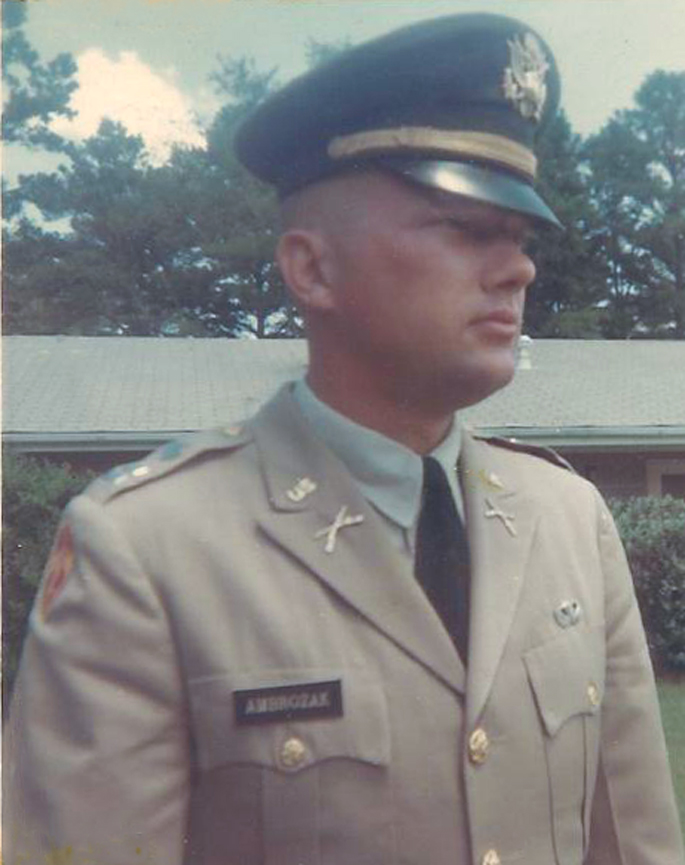
Ray-Ambrozak-1
Ray Ambrozak
Leave A Comment